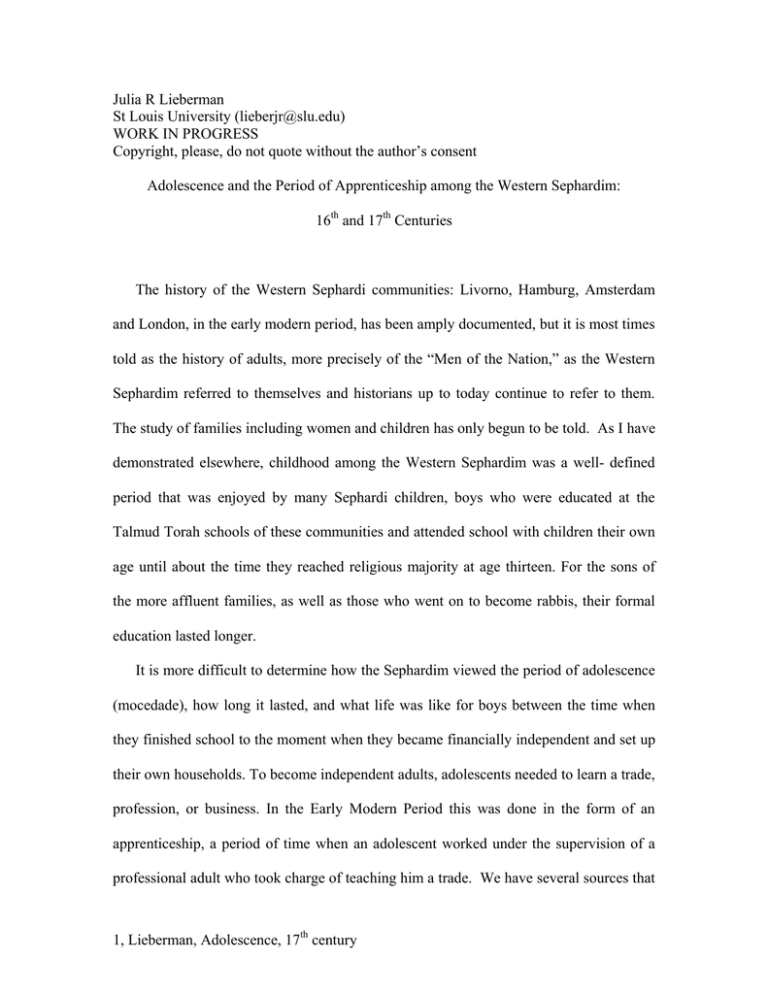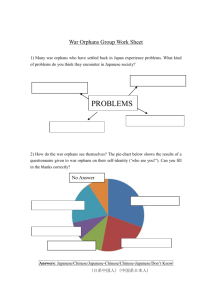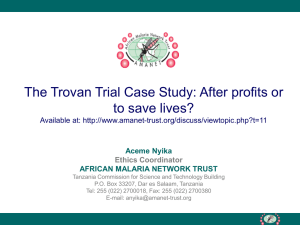Julia R Lieberman St Louis University () WORK IN PROGRESS
advertisement

Julia R Lieberman St Louis University (lieberjr@slu.edu) WORK IN PROGRESS Copyright, please, do not quote without the author’s consent Adolescence and the Period of Apprenticeship among the Western Sephardim: 16th and 17th Centuries The history of the Western Sephardi communities: Livorno, Hamburg, Amsterdam and London, in the early modern period, has been amply documented, but it is most times told as the history of adults, more precisely of the “Men of the Nation,” as the Western Sephardim referred to themselves and historians up to today continue to refer to them. The study of families including women and children has only begun to be told. As I have demonstrated elsewhere, childhood among the Western Sephardim was a well- defined period that was enjoyed by many Sephardi children, boys who were educated at the Talmud Torah schools of these communities and attended school with children their own age until about the time they reached religious majority at age thirteen. For the sons of the more affluent families, as well as those who went on to become rabbis, their formal education lasted longer. It is more difficult to determine how the Sephardim viewed the period of adolescence (mocedade), how long it lasted, and what life was like for boys between the time when they finished school to the moment when they became financially independent and set up their own households. To become independent adults, adolescents needed to learn a trade, profession, or business. In the Early Modern Period this was done in the form of an apprenticeship, a period of time when an adolescent worked under the supervision of a professional adult who took charge of teaching him a trade. We have several sources that 1, Lieberman, Adolescence, 17th century give us glimpses of apprentices and the expectations that adults had of them, –several are in the form of semi-fictional accounts of the lives of adolescents, others in ethical willsbut these sources are few and therefore insufficient for us put together a history of adolescence in Western Sephardi communities. Orphans however were a different story, as their names and other details of how the communities financed their care and education were recorded; such is the case with the register of the Abi Yetomim or Father of Orphans confraternity in Amsterdam which was founded in 1648. This institution took under its care fatherless young boys, between the ages of 10 to 13, and provided them with funding for lodging, food, clothing and some basic education, secular and religious; when these orphans reached age 13, some were dismissed but for others the confraternity also paid the cost associated with the learning of a trade as apprentices at the home of Jewish and in some cases non-Jewish senior masters. In this presentation I will probe this register for the purpose of finding out details of how the Western Sephardim viewed the period of adolescence, an important life stage during which boys learnt how to become productive members of the large or extended family that they called the Nation. Philippe Ariès in his well known and also often criticized book Centuries of Childhood concluded that the notion of adolescence as distinct from childhood did not fully develop until the eighteenth century. In the seventeenth century, he claims, it was still confused either with childhood or with adulthood. Among the Western Sephardim we have several ways to observe whether or not adolescence was viewed as a separate stage. In the merger agreement of the three 2, Lieberman, Adolescence, 17th century congregations into one in Amsterdam, in 1639, chapter 25 refers to how males were grouped for the purpose of being called up to the Torah: (1) the younger group was formed by the mosos up to 18 years of age; (2) the next group was formed by mansebos or males between 18 and 25; (3) the third group was made up of unmarried mansebos, 25 and older, and married men (omens cazados). In the same merger agreement, when it was made public to all congregants, the grouping of males was modified as follows: (1) mansebos up to 20 (that is to say the term mosos was replaced by mansebos and the age was raised from 18 to 20) (2) pesoas, married or single, 20 or older; (3) pesoas, 50 or older. For our purpose and interest in determining what was considered adolescence or mocedade, the two important terms are the adjectives mosos and mancebos. In contemporary Iberia these two terms each had a different meaning but were at times confused and used interchangeably. The term moço, according to Covarrubias in 1611, derived from the Latin adolescens, to grow, because as a plant, he (the moço) is in the process of growing up; it also means unmarried; finally it also refers to a servant (male or female moça). The meaning of mancebo, according to Covarrubias is a moço, from the Latin adolescens, who is a mancipium, because he is still under the control of his father as if he were a slave who has yet to earned his freedom or emancipation. Mocedade is not defined by Covarrubias, but about a century later, in 1726, the Diccionario de Autoridades indicates that mocedade begins at 14 years of age. It is also important to 3, Lieberman, Adolescence, 17th century note that in Iberia, a mancebo or unmarried man was dependent on his father until age 25, the age of legal majority, or until the young man got married with the consent of his father. In terms of the Jewish tradition, of course, the Jews of Amsterdam also referred to religious majority at age 13 and throughout the seventeenth century turning of religious majority was in the process of becoming marked with a special celebration or barmitzvah. In fact, several Spanish or Portuguese derashot delivered on the occasions of bar-mitzvah celebrations before the end of the 17th century also used the terms moso and mancebo interchangeably to refer to the celebrants. Now, let us move on to a brief history of the confraternity Father of Orphans of Amsterdam. It was founded in 1648 as an offshoot of another confraternity, the Gemilut Hasadim or Hebra dos Coveiros, founded in 1639 by Moseh Belmonte, whose member’s main task was digging up graves for burials as a pious deed. This institution acted independently of the Mahamad or lay leaders of the community. In 1648, after the death of Belmonte, the Mahamad took control of Gemilut Hasadamim and named its administrators. Some members voiced their objection to the take-over as they valued their independence and the Mahamad expelled them. Soon after and as an act of defiance to the Mahamad, 42 of the expelled men founded the Father of Orphans or Abi Yetomim confraternity. In order to justify their existence apart from the other confraternity, they gave up all the activities related to death and burial and instead they singled out two different tasks: (1) they took care of male fatherless orphans and (2) they provided lodging and food for a short time to newcomers from Iberian without financial resources of their own. 4, Lieberman, Adolescence, 17th century Soon after its foundation, membership grew to 60 and then to 100 members who paid an entrance fee of at least 20 florins and a monthly membership –tamid- of 10 placas. Women also were admitted and they paid an entrance fee of 11 florins and the same membership monthly fee of 10 placas (83 are listed at the founding). Upon their death, a number of members also made charitable bequests to the institution. The existence of so many specialized confraternities in Amsterdam and other Western Sephardi communities is notorious and merits some pause; their existence can only be understood if we take into account that in contemporary 17th century Catholic Spain and Portugal, men of all social classes also were customarily members of various confraternities. Iberian confraternities, numerous in every city or town, were of two kinds: (1) voluntary lay associations of men who paid membership and with the proceeds financed pious deeds such as feeding the poor, orphans, widows, etc., (2) and the so called guild-confraternities who performed the same type of pious deeds, but for their members and dependents in the case of illness or death of a member, as a kind of social security. In Iberia guilds and confraternities worked at times independently competing while others collaborating with the Catholic Church and the Crown, two institutions with a preference for centralization. The relationship with the Catholic Church assured them reward in the afterlife, as confraternity members gained indulgencies for sins committed. Another Spanish institution worth mentioning is the Father of Orphans, a paid position held by an individual employed by municipalities in various regions, such as Valencia, Navarra and Aragón. This urban institution, which was socially highly regarded, existed since the 14th or 15th centuries. The Spanish Jurist Vicente Pino who studied the one in the city of Zaragoza has traced its first statutes back to 1475. The 5, Lieberman, Adolescence, 17th century name, Father of Orphans, was really what Pino calls “a pious euphemism,” founded to take charge of what we would call today juvenile delinquents. This “Father” would go to public places where vagrant youth, male and female, would gather, took them under his legal charge and placed boys as apprentices with a master and girls as servants with a mistress. If a youngster, run away, the Father of Orphans, invested with the paternal authority of patria potestad, could imprison the youths and forced them to go back to his master or her mistress. In the founding of the Amsterdam Father of Orphans confraternity we observe influence of these various Iberian institutions: in the selection of its name which originated in Psalm 68:6, “Father of orphans and Defender of widows is God,” and was immediately translated into Hebrew or Abi Yetomim, in the desire of its members to be a voluntary association independent of the control of the Mahamad, and in the desire to care for their own as well as other less closely related in times of crisis, –a kind of Social security-. The most systematic records of the Father of Orphans of Amsterdam which has survived to our days is a register or accounting book that was started the year of its founding, 1648 and ended with records of the year 1768, but in this presentation I will only refer to the 52 years of the 17th century. As a register with an accounting purpose, it does not have all the information I was hoping to find. In fact the information entered in this register is often copied from another register, the Livro grande desta samta yrmandade (see fol. 16), which to my knowledge, has not survived. For example, it only has selected haskamot or statutes of the confraternity. But the register also has important information. In terms of the orphans the records were organized basically in two 6, Lieberman, Adolescence, 17th century different ways: (1) it lists the names of orphans the year they were admitted (although it does not give the precise age of the orphans) and occasionally it lists the orphans lodged in a given year; (2) the second type of recording was done when an orphan was awarded funding to learn a trade (colocados de oficio or posto aoficio), this type of recording, in the form of double entries (debe and haber), gives financial details of the costs of apprenticeship. It also suggests that the awarding of funding for apprenticeship was done in a kind ranking, giving priorities to the sons of members who passed away and then descending to others. It appears that not all orphans were awarded funding and at the end of their time in the orphanage they were dismissed, some to the care of their mothers. The records do not tell what happened later to these orphans. From the records of those who were awarded funding we can glean important information Orphans were admitted at the age of 10, first for a period of three years and later, since 1658, this period could be extended to up to three more years. The number of orphans lodged was low at first and the confraternity did not have for a while a designated house for the orphans. The year of its foundation, 1648, six orphans were admitted and were provided with an allowance of f. 45 per year, probably to cover the cost of lodging and food, clothing and medical care in case of illness. But three out of the 6 orphans admitted were expelled when the administrators found out that their fathers were alive. The following year (1649) another six orphans were admitted; in 1655 nine were admitted; in 1656 two were admitted, in 1657 one orphan was admitted. Although it is difficult to assess with precision how many orphans were served at one time (as the dates when they were expelled or dismissed are not given), I estimate that, up to 1657, there were at a given time, between 10 to 15 orphans; later on their numbers went higher. 7, Lieberman, Adolescence, 17th century Some of the orphans were admitted younger than 10; this is evident only if they were awarded funding for their apprenticeship but were still minors, (not yet 13) and therefore could not yet be placed as apprentices. In such cases they were allocated funding which was held until they turned of age. For example, Ishac Obediente was admitted in 1673 (5433), but three years later, in 1676 (5436) the confraternity awarded him funding (f150) to learn a trade, and referring to him as still a minor. Similarly Mosseh Nunes da Costa’s was admitted in 1675 (5435). Three years later in 1678 (5438), he was allocated funding (f150), but was referred as still a minor; he was finally placed as apprentice for three years with Isaac e Mosseh Henriques Faro to learn the trade of corredor which he successfully completed (received the quitansa) 12 years after he was admitted in 1687 (5447). Ishack de Mordehay Abendana also was dependent on the confraternity for a total of nine years, from 1689 (5449) to 1698 (5458), which included three years as apprentice of diamond cutter (lapidario) under his master Eliau Gaon. It is important to understand that at the end of the apprentice period, the orphan or any other apprentice was still dependent on a master to practice his trade for an indefinite period of time and many never made it to the rank of master. In some cases the children were expelled from the orphanage before the three allotted years because of behavior problems, described as: naughty (travieso), incapable of subjugation (por nao se sujeitar), because he was out of control (desosegado) in talking to the administrators, and even for being evil (velhaco). Some orphans left the orphanage of their own will (or perhaps the will of their relatives’) to travel to other countries where Judaism was permitted, or even to places such as Ireland, Bordeau or Antwerp where the 8, Lieberman, Adolescence, 17th century practice of Judaism was not allowed. Another reason for leaving the orphanage was marriage. This however did not happen very frequently, as an orphan was obligated to return his entire allowance if he quit before his time. Menasseh ben Israel in his Tesovro dos denim (Amsterdam 1647) gives the ideal age of marriage as 18 for a boy (13 for a girls), but the contemporary sources as well as recent studies tell us that the mean age for marriage among the Sephardim in Amsterdam, in the seventeenth century was 29 for a men (24 for a woman). From the date of its foundation, the Father of Orphans institution provided all orphans with clothing which is clearly described and for our purpose and interest reveals details of how adults viewed the needs of adolescents. It appears to me that clothing for orphans was not different from the clothing worn by adults, with garments appropriate for either winter or summer, such as the stockings (2 pairs knitted for the summer and two pairs made of an economic fabric for the winter). Every other year also they alternatively received either a winter vestment or men’s clothing worn over the shirt, of the same inexpensive fabric (vestido de pano) or a cape (capa para inverno). Every year, 2 shirts, which at the time was a garment that reached down to the knees and was worn directly over the body and served as a pajama at night; a hat and four pairs of shoes each year. Orphans also worn highly starched white collars (called valonas). We do not have a great of details en reference to the education provided to the orphans: they were taught reading and writing (I assumed in Spanish or Portuguese) and provided with some school supplies such as notebooks. The cost per pupil was rather low (f 7 per year), so they were probably taught by teachers not highly skilled. They also received a Jewish education. The details we have are in the form of an anecdote which 9, Lieberman, Adolescence, 17th century reveals that acceptance to the orphanage was probably considered by some as a way out of misery and poverty. In 1675, Manuel Palache requested entrance to the orphanage of David, one of his sons, alleging that he and another member of the family were among the founding members. The administrators, although they could not accept David, given that he was not fatherless, took in consideration the family’s dire situation as well as the child’s desire to be educated in the teachings of “the divine law and good doctrine” and admitted David to the orphanage religious school. Orphans also provided services to the confraternity. For example when members passed away they accompanied the procession from the home to the boat and to the cemetery for burial. They also The most fortunate among the orphans, it appears, where those who at age 13 or later were provided with funding to learn a trade. Some evidence suggests that there some kind of merit system, based on both personal merits as well as family. Frequently, those who were awarded funding were sons of former members of the confraternity, while in other cases orphans were replaced by another child because they could not learn the trade. The total cost of apprenticeship included a modest monthly salary for the orphan which was considered half of a servant’s salary. The most common trade was to become a diamond cutter (lapidario), but others learn to be booksellers or book dealers (livreiro), barbers or barber-surgeons, stock-brokers (corredor) and engravers (estampador). Some orphans, instead of a trade, were placed in the yeshivah, with the same rights as apprentices (meldar em lugar do oficio). In concluding, my survey of the Abi Yetomim or Father of Orphans register for the first 52 years of existence has led to believe that the period of ten to sixteen years of age 10, Lieberman, Adolescence, 17th century was considered a time of transition between childhood and youth or mocedade. At age ten orphans were separated from their home, even if they had a mother or other relatives. For three years, separated by gender, they were prepared to enter the period of apprenticeship with a basic education, secular and religious. They were dressed as adults and were made to listen, probably blindly, to their adults caretakers, with little room for expressing their own instincts. At age thirteen, when they reached religious majority, their transition from childhood to adolescence ended and they were no longer among peers. More importantly, their future was basically sealed, some returned to their broken homes to an uncertain future in the low levels of society, while the more fortunate ones were trained in professions or trades that ensured an entry into what we would call today, middle class. The three years of apprenticeship tested their readiness to their new stage in life, surrounded mostly by adults whom they had to imitate and obey. Mocedade or adolescence did not end at sixteen and in fact it could continue to last until about 25. 11, Lieberman, Adolescence, 17th century





